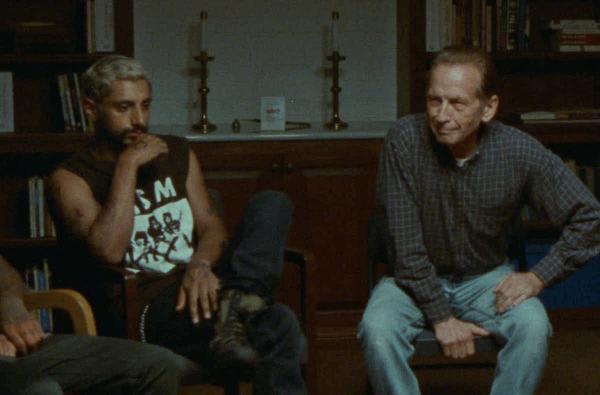Metal My Movie: Notions of Metal Sound through sound design in Sound of Metal

Content Warning: Mentions of drug addiction, self-harm, and suicidal thoughts
In this final Metal My Movie segment for the month of March I have decided to focus on one of the year’s best films. Leading the Oscar race with 6 nominations, Sound of Metal (directed by Darius Marder) is a film my cinephile friends and I have been waiting to see since its preproduction days under the original title Metalhead. The film’s concept of a heavy metal drummer learning to cope with losing his hearing due to his eardrum being ruptured stemmed from Metalhead director Derek Cianfrance. That version starred the members of two-piece American sludge metal band Jucifer, but unfortunately the project fell through. However, the same concept would come to be known as Sound of Metal, albeit without an actual metal band. Riz Ahmed stars as Ruben, the drummer in a heavy metal punk band that is losing his hearing. Cianfrance is still given writing and executive producer credits on the film alongside Marder. If we look at the character of Ruben and the sound design of the film, we may not get the obvious answer to what metal sounds like, but we do get notions of it through the distinction of the sound of metal found in the sound design to heighten our experience with Ruben through his hearing loss.
Ruben is a drummer for the duo metal band Blackgammon alongside lead singer and girlfriend Lou (Olivia Cook). They live their life on the road in an RV, driving to the next gig but never living fully in the moment. Something is not right when Ruben discovers that he has issues with his hearing and is referred to getting a hearing test by a pharmacist. The test results show that Ruben can only make out 20-30 percent of what he hears, and it is recommended that he stay away from loud noises. Rather than taking the advice and stepping away from his life of performing, Ruben looks to take advantage of a quick fix solution by getting a cochlear implant. To get the money for the surgery, Ruben continues to risk his ears to the exposure of the loud noise of performing. The sound design in this chapter focuses both on what the experience is like at a loud concert and what it is like being a drummer close to loud equipment. It does so while placing the audience into Ruben’s shoes as his condition worsens with the sound design mimicking the incoherent nature of losing the noise around you.
When Lou learns of Ruben’s condition, she expresses concern for his safety and sobriety as she fears he may relapse into his drug addiction. They contact his sponsor Hector, who finds a Deaf-led support group for Deaf people who are recovering addicts. Joe (Paul Raci) tells Ruben that the group is not about a quick fix, a usual tactic of Ruben's, but rather about learning how to live with his new reality. At first reluctantly engaging with the community by working with Deaf children in a classroom, he also begins learning American Sign Language and participates in a form of therapy that requires getting up early and being alone with his thoughts. Joe tells him to write in a journal when the silence becomes too uncomfortable and he has trouble sitting still. These scenes showcase Ahmed’s ability to convey pain and anguish in Ruben’s writing and verbal reactions, including the character screaming out of frustration while in therapy. The sound design in this section focuses more on characters being comfortable with profound moments of silence and living in silence. There is one good scene in this chapter where Ruben is with one of the students on a metallic slide outside of school and the student makes a rhythm on the slide, which Ruben repeats. This represents a shift from the booming nature he once only heard on the drums, to him feeling it too.
As much as he integrated himself with the support group, Ruben still wants his old life back and feels that the cochlear implant will be the quickest solution. After informing Joe that he has had the surgery, Ruben is asked to leave the group as his decision to get the cochlear goes against their philosophy of not viewing Deafness as a problem to fix. When he activates the implant, he is reintroduced to greater access to sound. Instead of being comforted by this, he finds it slightly jarring and unfamiliar. He takes a plane to Belgium to see Lou and tries his best to interact with others but faces difficulty adjusting to sounds heard with the cochlear implant. The final scene in the film - a coda, if you will - shows Ruben by himself on the busy streets of Europe with people rushing by him as a church bell rings loudly. He removes his cochlear, finally realizing that it is alright to be with himself and appreciate the silence around him as opposed to the loudness of his previous life. A great use of sound design in this chapter from any film that I can remember is when we are quite literally in Ruben’s shoes when his implant gets switched on. The sound can be described as tinny or canny, whereas Ruben describes it as a distorted, jarring high-pitched sound. This is what most of this chapter sounds like when we bounce from the movie’s audio to Ruben’s audio, making this a great innovative use of sound design and character reflection.
Rather than diving in into a clear consensus on what metal sounds like, we get the idea through the character of Ruben through sound design moments in the film Sound of Metal. For this reason alone, it is not only a cinematic achievement in my view when it comes to sound design for a film putting you in the shoes of a character, but it is also truly deserving of this final Metal My Movie segment for Metal March.
Got a movie you want to see featured on Metal My Movie next March? Send over your suggestions to atmovies@cjlo.com. A big thank you to the magazine team behind the scenes with your help editing and publishing these segments.
Remi hosts At The Movies with regular Co-Host Danny every Tuesday morning from 8-9 AM only on CJLO 1690 AM.




